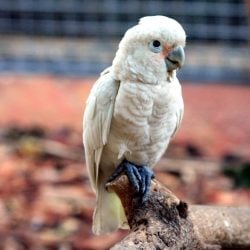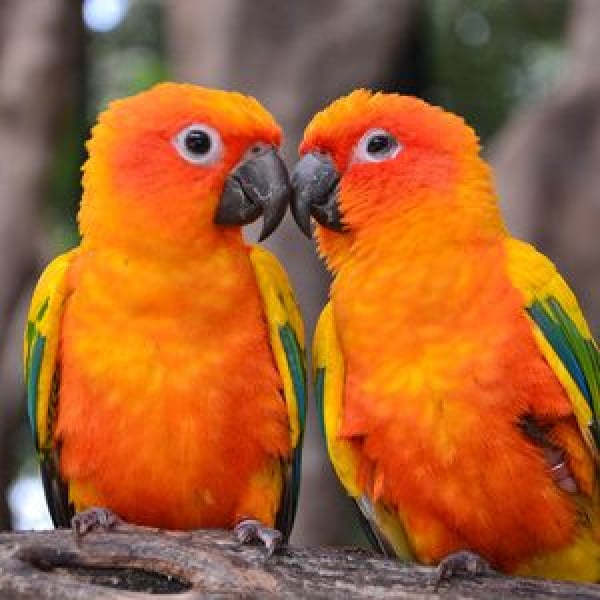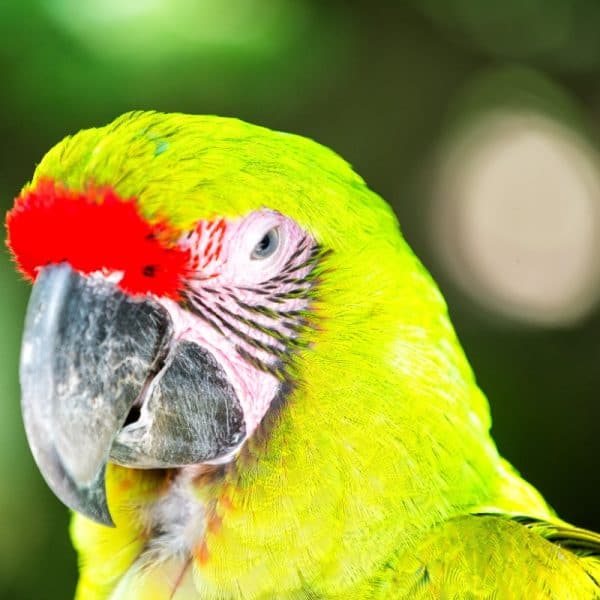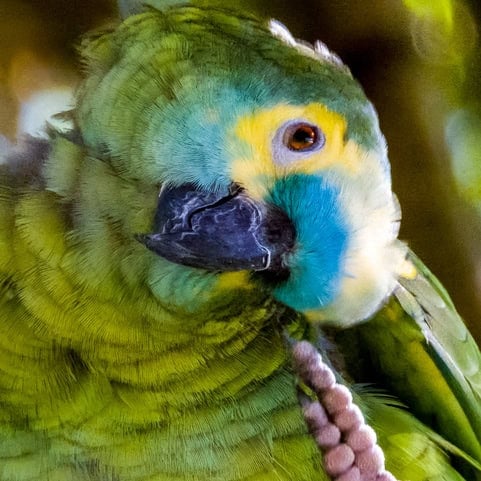Last Updated on by Catherine Tobsing
From Veronica
Hello again. We have chatted before. thanks for the previous advice.
We have a one-year-old female sun conure and we are thinking about getting her a buddy. Perhaps a male sun (red factor) or just another parrot critter. If we chose another species, what would you suggest as a good companion for her, not including parakeets for cockatiels?
Thanks
Hi Veronica and thanks for asking Windy City Parrot for advice on your situation.
I am sort of the sun conure expert around here I guess, having owned 3 personally at various times in my life. My first I bought as a baby, just weaned. The second a lady gave me as a young bird but she passed away in a very unfortunate accident and the third I did the final hand feeding only to have him fall in love with my boyfriend so, when we split up, I let the sun conure stay with the ex because Mango would have missed him so terribly and I had to think of what was best for the bird.
I have to ask you a couple of questions and once I have the answers I will be able to provide more advice (so please get back to me on it): WHY do you want to get your female sun a buddy? And is your female sun DNA sexed to be sure she really is a she? Okok, I’m going for 4 questions: Do you plan to house them in the same cage? And why do you rule out parakeets?
I’m going to answer your question from personal experience. When my first sun conure, SunDance, was 10+ years old she made it perfectly clear she wanted a mate. So we let her choose one.
My elderly mom and I shared a condo that was all-tile flooring, but had plenty furniture and wall decor in the great room where SunDance had her house (read cage if you prefer). We had area rugs on the floor and the neighbors never heard any real noise from her unless they were outdoors. She was not a screamer, just the usual morning welcome calls, goodbye screech when she we told her “bye, we’ll be back soon”, and hello calls plus the normal conure screams of fear from lawnmowers, hawk-like birds or shadows, flashing lights, etc., and an occasional contact call which, if answered, ended the calling. She was quiet for a sun conure. We were very happy with her noise level and so were our neighbors and friends.
So, since she wanted a partner/mate, I decided to let her choose one. She did. Now we had two sun conures making all the above normal calls each BUT we also had the contact calls between the two, even after the quarantine period and they lived in the same huge cage.
You have no idea how loud two sun conures calling in unison or to each other can be. Suddenly it seemed the very earth echoed every call. And when bonded birds, even if not mated, make contact calls it tends to go like this: she calls, he answers, she answers, he answers ad nauseam ad deafness….you get idea. Suddenly it was nerve wrecking.
That is one issue with adding either same gender or a pair of sun conures inside a home. You’ll read more about these two in a future Birdie Brunch post. But the point is, one bird makes some noise, the other bird makes some noise but in this situation 1 plus 1 can equal 12+ in the noise increase!! Not to mention there was twice as much mess to clean up, but if that were the only issue, things would have been happy.
Eventually because the two did not mate (I didn’t know at that early state of parrot learning that breeding wasn’t a great idea anyway) and the noise was making mother and I want to run away from home, we were forced to rehome the male. Had they been forced to live in two cages I think the noise would have been much worse.
Screaming Conure
Secondly, if you place a male and female of the same species or ones close enough to mate successfully together and they bond, nature (in most cases, not in my two) takes it’s natural course and you can end up with babies.
There are far, far too many unwanted sun conures in rescues to add more babies into the world unless they are of very special gene pools, strong ones and both birds have had an absolutely perfect diet and exercise program all their lives — plus their ancestors had to have had the same. Otherwise, you could end up with bad-natured babies, chronic egg laying, or in the worst case, an egg-bound hen that you don’t get help for in time and you lose your beloved friend.
Even if you got a second parrot of the same gender or a totally different species that would adapt and be friends with your sun conure so there would be no babies, hormones could still result in eggs and potential egg binding.
Thirdly, conures like most parrots are flock animals. Right now your young sun is precious and cute and probably interacts with you all the time when you are home. This is because a single tame companion parrot accepts the humans in the household as its artificial flock, eating when they do, wanting to be with the family, wanting to be loved, tickled and given attention, and generally with conures and suns especially, cuddled and snuggled with. When you add another parrot of similar size, even if not of the same species, to the mix, your beloved companion may have no need of you as a flock member, becoming untamed and wanting little or nothing to do with you.

These two conures create their own flock and don’t need a human flock
If you fear your bird is lonely during the times of day that perhaps you have to work outside the home, if you have provided a rich cage environment with lots of chewing, foraging, perches of different textures and sizes including soft perches, climbing and challenging toys, a place for privacy and lots of interesting foods, the bird will be happy enough while you are away as long as you spend QUALITY out of cage time with her when you get home. For more info on these issues, please read blog post and “The Cage Canopy Concept”. Many companion birds sleep a lot of the time their humans are away, eating, playing then napping for quite a while, and repeat.
Unless you are away a great deal, say sunup to darkness 6 days or more per week and busy most evenings so that you can’t give your bird quality time with you, the bird is happy enough as a single parrot. Please excuse any missing images, videos or links in the referred blog posts as we are still putting the final paint and polish in some places from our recent website redesign and migration. We kindly ask that you bear with us.
I actually twice have had a sun conure voluntarily allow a parakeet to move in with the bigger bird and live happily together. They didn’t play together a lot, but they got along well and clearly wanted to reside together since in both cases each bird had its own perfect cage with everything it could want. Keets are so tenacious they simply won’t allow a sun conure, usually a rather ‘fraidy bird’ personality type, to hurt them or run them over. Of course I did supervise quite a while before I allowed this situation to be the norm to ensure no harm to either bird.
But if you can provide your young sun conure with quality out-of-cage time with the human family on a daily basis — QUALITY being the keyword rather than length actual number of hours — you will probably be happiest with one tame, snuggly loving sun conure.
Instead of spending a lot of money on an additional living creature that may make things LESS perfect rather than more perfect, why not get lots of toys, interesting ways to serve food like kabobs, foraging opportunities, and puzzles (most conures love puzzles, untying knots, challenges) so that when your bird has to be in its cage it is happy, entertained when not napping, and will be thrilled when you do arrive home and include her in your daily life.
Conure solves puzzle toy
Change toys often except for one or two favorites that can be moved (and her bed if she uses one), rearrange, reintroduce, buy a play stand or cage for every room where the bird may be with you, and the best food (and supplements if a seed diet is used but not needed if top-quality pellets are fed) and treats as well as healthy human foods.
And don’t forget the yearly well-bird checkups with the best avian vet in your area so you have a relationship and records should illness or accident (or the aforementioned egg binding) strike.
Check supplies of every type suitable for a conure, health, first aid, grooming and similar needs, stands for placing in other rooms or areas where you spend time with your bird, and habitat enrichment. Also if you wish to keep her flighted, a harness or flight suit is ideal so she can go outdoors for healthy air and sunlight while watching that she doesn’t get too hot or cold.
Notice in the habitat area that the bird in the “bedtime” subcategory is a sun conure and at the bottom of the page is the story of my Mango getting a new Snuggle Hut. These birds seem to have a need to hide when sleeping, at least in my experience, though a privacy area can work if you don’t like the idea of a bed. Oh, and just in case something got missed in our recent move, but sure to go through toys, especially preening/foraging and interactive ones, and food sections.
If you have further questions or if I can help in any way, please just contact me. After all, it’s all about birds and We Speak Bird!
Written and approved by the Windy City Parrot content team
Author Profile

Latest entries
 Bird & Parrot CareJune 20, 2025Understanding the Best Way to Use Prevue Pets Mimic Me Voice Trainer
Bird & Parrot CareJune 20, 2025Understanding the Best Way to Use Prevue Pets Mimic Me Voice Trainer Bird BehaviorJune 6, 2025How Do I Keep My Parrot From Dumping His Food Every Day?
Bird BehaviorJune 6, 2025How Do I Keep My Parrot From Dumping His Food Every Day? Birds & LightingMay 16, 2025I Am Seeking Clarity About Lighting for My Birds Cage
Birds & LightingMay 16, 2025I Am Seeking Clarity About Lighting for My Birds Cage Bird RescueApril 29, 2025How Do We Re-Home a 17 yr Goffin Cockatoo?
Bird RescueApril 29, 2025How Do We Re-Home a 17 yr Goffin Cockatoo?




